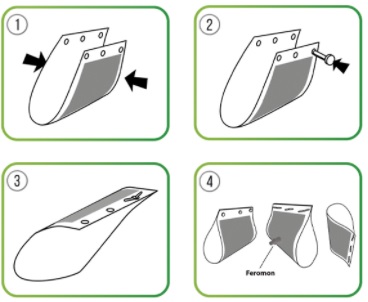Catalogue of traps and pheromones
Download traps and pheromones list

Download document
1.02 mb
A dangerous pest of grain, forms a latent form of infection. It develops in soft wheat grains, as well as in other cereal seeds.
The life span of beetles is from 3 to 6 months. Beetles remaining for the winter live up to 8 months; wintering sites are grain mounds, underground galleries, rodent burrows and other secluded places in unheated rooms.

Rice weevil lays up to 500 eggs. The optimum temperature for development is 28 - 30 ° C, and grain moisture 18%. Under these conditions, the development cycle lasts 23 -25 days. The development of one generation at 21 - 25 ° С lasts about 40 days, and at 14 -18 ° С it takes up to 3.5 - 7 months.
Rice weevil damages grain of rice, wheat, rye, corn, barley, flour, beans, hemp seeds, pearl barley and dry flour products, millet seeds, oilseeds and legumes.
As a result of the development of rice weevil, cereal grains lose 35 to 75% in weight.

The hotbed are plant residues accumulating from year to year on the currents with the presence of grains of various cereal crops. The annual accumulation of unusable grain waste allows the beetles to remain in them for a long time.
Proper use of Pheromone Traps:
The pheromone trap is designed to monitor and reduce pest numbers. In order to determine the population density of pest insects and to identify pest outbreaks (monitoring), it is recommended to use 1 trap per 1 ha.
The trap should be placed as near the culture at the middle of the plant. Prior to the first flight of the thrips, the traps must be checked on a daily basis, and after the first thrips have been captured, the traps must be checked every 5-7 days. Pheromone dispensers can be changed after 4-6 weeks and sticky tapes can be replaced when is full with pests and dust. Protective measures are based on the results of the monitoring of population density of pest insects.
Trap placement:
For mass capture and sterilization of males, it is recommended to have more than 20 traps per hectare in opened field. In case of a large number of pest insects use 30 traps per 1 ha in opened field. In greenhouses it is recommended to have more than 15 traps per hectare. In case of a large number of pest insects use 20 traps per 1 ha.


Download traps and pheromones list

1.02 mb
Review our catalogue of pheromons and semiochemicals by chemical name

525.1 kb